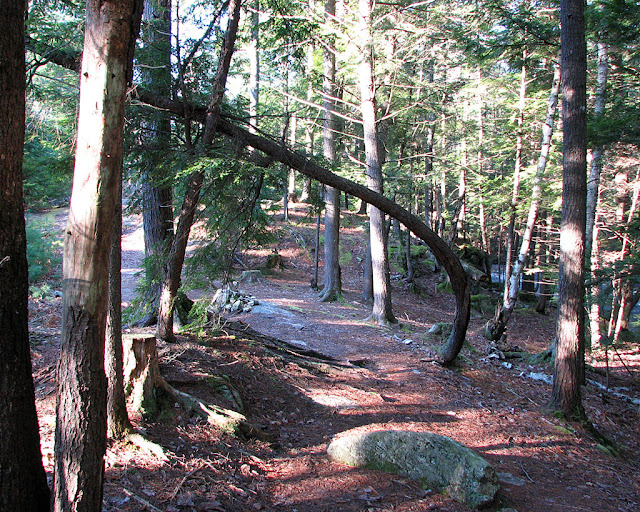 |
| “Cold Regions Research and Engineering Laboratory.” U.S. Army Engineer Research and Development Center (ERDC), 17 Jan. 2020, https://www.erdc.usace.army.mil/Locations/CRREL/. |
First of all, here is a chart about ice thickness and the amount of weight it can support! And, here is some general information about ice from the US Army Corps of Engineers (with photos from my archives to illustrate the information):
 |
| Strong, new ice on Caesar Pond |
New ice is much stronger than old ice, as a rule. Ice from direct freezing of lake water will be stronger than ice formed from snow melt, refrozen ice or ice made by water bubbling up through cracks and freezing on the surface. Several inches of new ice may be strong enough to support you, while a foot or more of old ice might not.
 |
| A spring and an entry hole next to the beaver lodge |
Judging the safety of ice requires consideration of several factors, including its appearance, the daily temperature, thickness, whether the ice is or isn’t covered with snow. The depth of water under the ice, size of water body, water chemistry, distribution of the ice and local climate also contribute to the equation.
 |
| Variable ice depth from the dock to further out on Caesar Pond |
Ice rarely freezes or thaws at an equal and uniform rate across a body of water. It can be a foot thick in one spot and only an inch thick a few feet away. A layer of snow insulates ice, slowing down the ice forming process. In addition, the weight of snow can reduce the amount of additional weight the ice can bear.
 |
| Near shore ice is thinner and melts faster - darker surfaces of grasses and muck absorb the heat. |
Ice near shore is weaker, not stronger, than ice farther out. Buckling of the lake or stream over the winter breaks and refreezes ice continually along the shore.
 |
Springs on the pond have moving water that makes the ice thinner.
I marked their locations while walking all over the pond on Dec. 27, 2011. |
Ice formed over flowing water can be dangerous near shore, around inflowing or outflowing streams, or on lakes containing large numbers of springs.
 |
One of the springs on Caesar Pond with very thin ice around its perimeter.
It takes a longer time to freeze over to safely support a person's weight
than ice that does not have flowing water underneath. |
 |
| Another spring near the north outflow of the pond. |
 |
| The Sabattus River takes longer to freeze due to moving water. |
River ice is roughly 15 percent weaker than ice on lakes, and straight, smooth flowing stretches are safer than river bends.
 |
| Early in winter the ice comes and goes. This is meltwater on top of ice that will freeze over again. |
A potential danger spot on lakes is an open portion completely surrounded by ice. Winds will force exposed water beneath the ice and cause the ice to deteriorate from below.





























